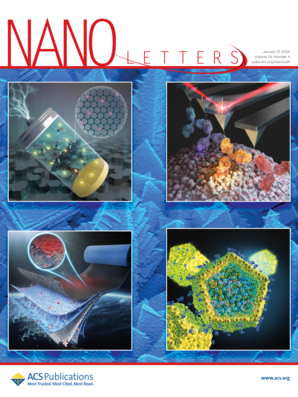自捕获激子或Bi3+离子在无铅双钙钛矿中的广泛发射?倾听压力在说什么
IF 9.6
1区 材料科学
Q1 CHEMISTRY, MULTIDISCIPLINARY
引用次数: 0
摘要
ns2金属离子掺杂的无铅双钙钛矿的广泛发射源是一个长期存在争议的问题。本文引入压力作为确定Cs2AgIn0.9Bi0.1Cl6纳米晶体(NCs)宽发射机制的有力工具。压缩下晶体场强与宽发射波长之间的负相关证实了宽发射确实归因于自捕获激子的辐射重组,排除了Bi3+从3Pn (n = 0,1或2)发射到1so0作为替代机制的可能性。由于BiCl6-AgCl6和InCl6-AgCl6的结构不同,宽发射由两种自困态组成。在5.01 ~ 10.01 GPa范围内的异常发射增强是由于BiCl6八面体的局部畸变导致激子-声子耦合强度增加所致。我们的研究阐明了长期以来关于Cs2AgIn0.9Bi0.1Cl6 NCs宽发射起源的争议,在精确设计和合成靶向无铅双钙钛矿材料方面迈出了重要的一步。本文章由计算机程序翻译,如有差异,请以英文原文为准。

Self-Trapped Excitons or Bi3+ Ions for Broad Emission in a Lead-Free Double Perovskite? Hearing What Pressure Says
The broad emission origin of lead-free double perovskites with ns2-metal ion doping remains a long-standing controversy. Herein, pressure is introduced as a robust tool to determine the mechanism of broad emission from Cs2AgIn0.9Bi0.1Cl6 nanocrystals (NCs). The negative correlation between the crystal field strength and broad emission wavelength under compression corroborates that the broad emission is indeed attributed to the radiative recombination of self-trapped excitons, ruling out Bi3+ emission from 3Pn (n = 0, 1, or 2) to 1S0 as an alternative mechanism. The broad emission is composed of two types of self-trapped states due to the different structures of BiCl6–AgCl6 and InCl6–AgCl6. The abnormal emission enhancement within the range of 5.01–10.01 GPa results from the local distortion of BiCl6 octahedra that increases the exciton–phonon coupling strength. Our study elucidates the long-term dispute about the origin of broad emission in Cs2AgIn0.9Bi0.1Cl6 NCs, representing a significant step forward in the precise design and synthesis of targeted lead-free double perovskite materials.
求助全文
通过发布文献求助,成功后即可免费获取论文全文。
去求助
来源期刊

Nano Letters
工程技术-材料科学:综合
CiteScore
16.80
自引率
2.80%
发文量
1182
审稿时长
1.4 months
期刊介绍:
Nano Letters serves as a dynamic platform for promptly disseminating original results in fundamental, applied, and emerging research across all facets of nanoscience and nanotechnology. A pivotal criterion for inclusion within Nano Letters is the convergence of at least two different areas or disciplines, ensuring a rich interdisciplinary scope. The journal is dedicated to fostering exploration in diverse areas, including:
- Experimental and theoretical findings on physical, chemical, and biological phenomena at the nanoscale
- Synthesis, characterization, and processing of organic, inorganic, polymer, and hybrid nanomaterials through physical, chemical, and biological methodologies
- Modeling and simulation of synthetic, assembly, and interaction processes
- Realization of integrated nanostructures and nano-engineered devices exhibiting advanced performance
- Applications of nanoscale materials in living and environmental systems
Nano Letters is committed to advancing and showcasing groundbreaking research that intersects various domains, fostering innovation and collaboration in the ever-evolving field of nanoscience and nanotechnology.
 求助内容:
求助内容: 应助结果提醒方式:
应助结果提醒方式:


